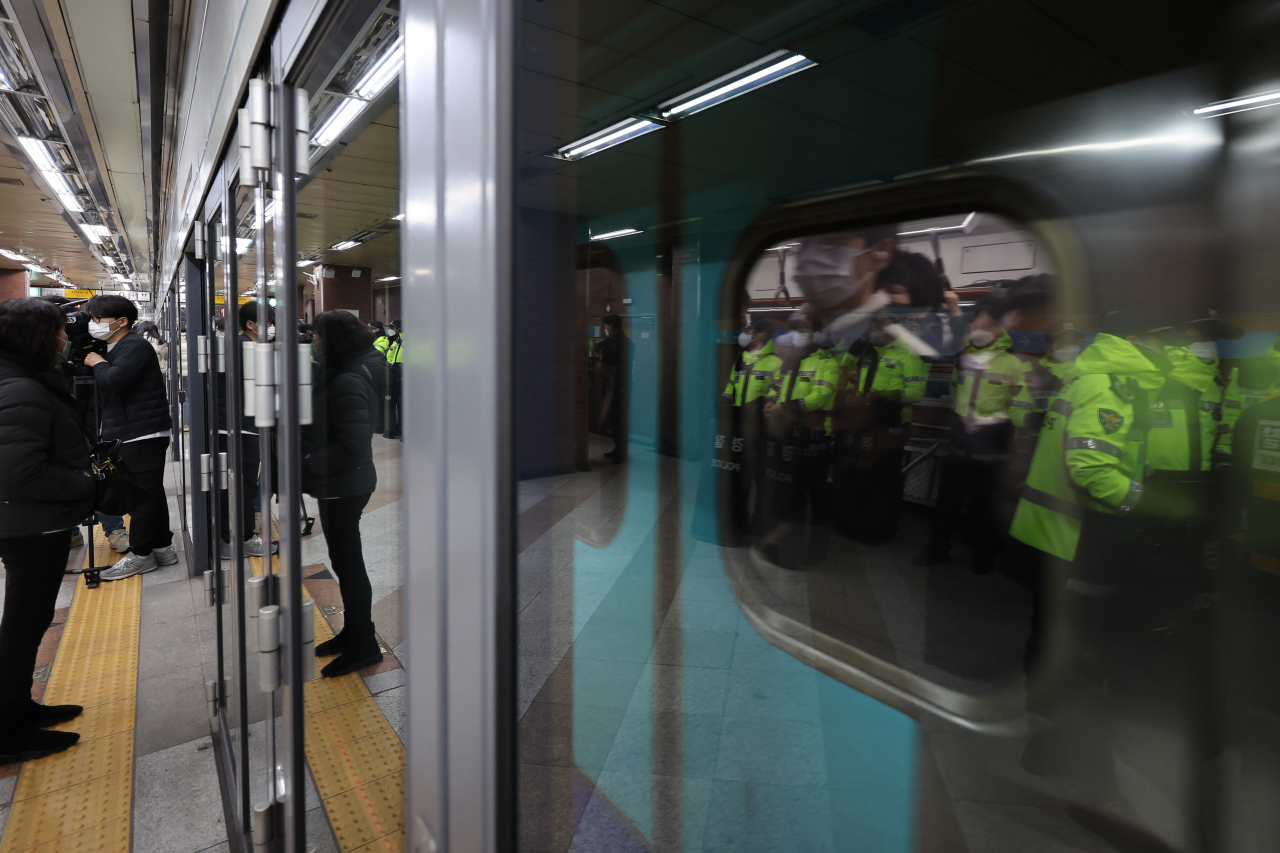Despite cold eyes, disabled on wheelchair continue subway protests
Activists defy public resentment, chain themselves to train doors. Here’s why.
By Park Jun-heePublished : Dec. 14, 2022 - 15:43

While the season’s freezing temperatures gripped South Korea on Wednesday morning, a group of disabled protesters on wheelchairs staged their rush-hour subway protests at around 8 a.m. -- once again paralyzing train operations at Samgakji Station on Seoul’s subway Line No. 4.
The 15 protesters are from Solidarity Against Disability Discrimination, Korea’s largest disability rights group. Protesters usually stand in front of subway doors to stop people from entering and exiting, thus delaying the trains’ operations. In previous protests, trains were delayed for hours at a time.
Despite unfriendly glances from commuters running late for work, the disabled activists have demonstrated 48 times since December 2021, urging the government and political parties to increase the budget for disability rights and provide measures to improve mobility rights.
Those demands include the installation of elevators in all subway stations and increasing the number of low-floor buses. The group insists that the country doesn’t have proper rehabilitation and welfare services for the disabled.
Currently, a total of 256 wheelchair-accessible elevators are installed at 275 subway stations on Line Nos. 1-8, according to Seoul Metro.
On Tuesday, Park Kyoung-seok, the chief of SAAD, held a press conference at Samgakji Station, asking the government to do more to help disabled people.
“Pass a budget that guarantees the rights of the disabled during the National Assembly plenary session so that (we) won’t take the subway anymore during commute time,” Park demanded.
Disability activists often threw themselves onto trains and subway platforms, bringing morning public transportation commutes to a standstill so that people could no longer ignore them.
Some protesters have even chained themselves to train doors, preventing subway trains from departing. The protesters did so to highlight the height difference between the door and the platform, a major inconvenience for disabled riders here.
While some perceive the series of rallies as socially oppressed people banding together to create social change, others take a different view. Some citizens have expressed displeasure toward the group, as the group’s demonstrations often caused delays in subway operations during rush hours.
“I have to transfer at Samgakji Station to go to school, and a 10-minute pullover delays the arrival time by at least 20 to 30 minutes,” said Lee Ji-hun, a 25-year-old student who lives two hours away from his university. “Those who have experienced the protest will not be able to root for the disabled group,” Lee added.
Experts say that ignorance and treating the disabled as inferior have fueled such demonstrations.
“The protests can’t be rationalized, but there’s a reason these people are staging protests, risking their lives and enduring criticism – it’s for better rights and increased government spending. Disabled people have been forced to make concessions to all able-bodied people. It’s time for their voices to be heard now,” said Lee Ju-eun, an attorney at the Association for Public Interest Law.
Jung Jae-hoon, a social welfare professor at Seoul Women’s University, echoed this opinion.
“It’s the result of what Korean society has ignored for decades. That’s why disabled activists radically raise their voices for attention, to bring more eyes to the issue. But instead people are finding fault with the group, emphasizing the inconvenience they’ve experienced,” Jung said.



![[Exclusive] Korean military set to ban iPhones over 'security' concerns](http://res.heraldm.com/phpwas/restmb_idxmake.php?idx=644&simg=/content/image/2024/04/23/20240423050599_0.jpg&u=20240423183955)

![[Graphic News] 77% of young Koreans still financially dependent](http://res.heraldm.com/phpwas/restmb_idxmake.php?idx=644&simg=/content/image/2024/04/22/20240422050762_0.gif&u=)



![[Pressure points] Leggings in public: Fashion statement or social faux pas?](http://res.heraldm.com/phpwas/restmb_idxmake.php?idx=644&simg=/content/image/2024/04/23/20240423050669_0.jpg&u=)










